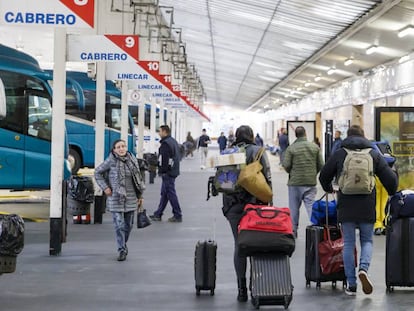Spain’s rural areas have the worst access to basic services in the EU
Country dwellers in parts of Castilla-La Mancha, Aragón and Castilla y León have to travel on average more than 25 kilometers to reach a health clinic or a supermarket, according to a study by the Bank of Spain
Rural areas in Spain have worse access to services compared to other European Union countries, according to a study by the Bank of Spain. Titled “Access to Services in Rural Spain,” the report analyzes the distances citizens need to travel to access basic services such as health clinics, nursery schools, supermarkets, hospitals, sports centers and libraries. It concludes that, while in urban areas, a person has to travel on average a similar or even slightly shorter distance than in other European countries, in rural areas, the distance is somewhat greater, especially when it comes to local rather than regional services, such as primary healthcare or supermarkets.
In rural areas of Castilla-La Mancha, Aragón and Castilla y León, citizens are on average more than 25 kilometers away from such local service. According to the analysis, this deficit could be explained in part by the terrain. In Spain, the more mountainous, isolated areas along with the greater distances from large cities and the coast compared to other European countries has a negative impact on access to services. In other words, rural areas in Spain are more remote. In fact, take away the isolation factor and accessibility actually improves, according to the study.
The Bank of Spain’s last annual report pointed out that Spain’s population is highly concentrated, leaving an abnormally high percentage of uninhabited territory. If the territory is divided into one-kilometer blocks, only 13% of these are significantly populated. The rest of the map shows a large empty area, matched only within Europe by Lapland.
In rural provinces, the average Spanish citizen has to travel 12.4 kilometers to the nearest local service, compared to 4.8 kilometers in Germany
A high concentration of a country’s population facilitates cheaper services per person, according to the study, which also recognizes that demographic dynamics can have implications that can lead to social discontent. “The debate surrounding the inequalities between rural and urban areas regarding access to services has gained ground,” it states, in clear reference to movements such as Teruel Existe, a citizen platform turned political party that was originally created to draw attention to the lack of infrastructure in the province in Aragón.
The average Spanish citizen has to travel about 3.5 kilometers to access the nearest local service, compared to four kilometers for the average EU citizen. However, this is not the case when it comes to rural provinces where more than 50% of the population lives outside urban areas and where there is no urban area with more than 200,000 inhabitants. Here, the average Spanish citizen has to travel 12.4 kilometers to the nearest local service, compared to 4.8 kilometers in Germany, 7.6 kilometers in France and 4.7 kilometers in Italy. In a province such as Teruel, this distance can be as much as 20 kilometers. In Zamora, located in Castilla y León, it is 16.4 kilometers and in Cuenca in Castilla-La Mancha, 15 kilometers.
If we compare the differences within Spain, people living in the countryside have to travel an average of 20 kilometers more than those living in cities to access a local service. In Castilla-La Mancha, a rural citizen has to drive 34.33 kilometers to a local service. In Aragón, 29.94 and in Castilla y León, 26.7. On the other hand, in Andalusia it is 12.71; in Galicia, 14.68; and in Catalonia, 12.85.
Meanwhile, to reach a regional service such as a hospital, the average distance in Spain is 27.2 kilometers compared to 30 kilometers in the EU. When it comes to regional services such as these, Spain’s rural provinces are no different from the rest of Europe. However, in rural enclaves such as Teruel, Cuenca, Cáceres in Extremadura, Soria in Castilla y León and Lugo in Galicia, distances range between 89 and 118 kilometers. The diversity of access is great, as the study points out.
“In Spain, rural areas have worse accessibility to services than their European counterparts, while the differences are not significant in the case of urban areas,” the study concludes, adding, “The ease of access to services for the citizens of a country or region can be considered an indicator of its degree of economic and social development.”
Lower taxes
The fact that there is a lower amount of tax going into the public coffers in rural municipalities may also contribute to this phenomenon, according to the study. This is due to both a smaller population and a lower tax rate – property and road tax rates fall depending on the size of the area. Small municipalities also depend more on transfers from other levels of government, face higher fixed costs per inhabitant, especially in very remote areas, and incur less debt than large cities. All this has an impact on their capacity to finance local services. However, the Bank of Spain does not explain whether they have worse services because they have lower taxes and less capacity to go into debt, or whether they set lower rates because the population is smaller and they are trying to attract more inhabitants.
Within the context of the demand for more resources for “empty” depopulated Spain, the Bank of Spain recognizes that rural Spain has worse access to services. In its annual report, it actually stated that minimum levels must be maintained. But it also called for caution: “These policies can reduce territorial disparities, but sometimes they can also result in a loss of efficiency.” It also stressed the importance of establishing partnerships between municipalities to generate economies of scale and to take advantage of opportunities in leisure, teleworking, internet sales, renewables and the care-work sector. However, in order to promote these activities, high-speed internet is essential, and the study points out that there are still large differences in coverage between rural and urban areas.
English version by Heather Galloway.
Tu suscripción se está usando en otro dispositivo
¿Quieres añadir otro usuario a tu suscripción?
Si continúas leyendo en este dispositivo, no se podrá leer en el otro.
FlechaTu suscripción se está usando en otro dispositivo y solo puedes acceder a EL PAÍS desde un dispositivo a la vez.
Si quieres compartir tu cuenta, cambia tu suscripción a la modalidad Premium, así podrás añadir otro usuario. Cada uno accederá con su propia cuenta de email, lo que os permitirá personalizar vuestra experiencia en EL PAÍS.
¿Tienes una suscripción de empresa? Accede aquí para contratar más cuentas.
En el caso de no saber quién está usando tu cuenta, te recomendamos cambiar tu contraseña aquí.
Si decides continuar compartiendo tu cuenta, este mensaje se mostrará en tu dispositivo y en el de la otra persona que está usando tu cuenta de forma indefinida, afectando a tu experiencia de lectura. Puedes consultar aquí los términos y condiciones de la suscripción digital.
More information

Why college graduates are leaving Spain’s deserted interior for Madrid
Últimas noticias
The life of a delivery driver in China: ‘Many people don’t know how an order can arrive at their home in just one day’
Maude Apatow, from acting in ‘Euphoria’ to directing: ‘There are many films that you can tell weren’t written by someone young’
Helen Levitt, the photographer who captured the theater of the everyday
The guardians of the meteorites of the Argentine Chaco
Most viewed
- Christian Louboutin: ‘Young people don’t want to be like their parents. And if their parents wear sneakers, they’re going to look for something else’
- US sanctions against jailed cartel leader ‘El Marro’ highlight Mexico’s lack of control over its prisons
- Cartels in Mexico take a leap forward with narco-drones: ‘It is criminal groups that are leading the innovation race’
- Liset Menéndez de la Prida, neuroscientist: ‘It’s not normal to constantly seek pleasure; it’s important to be bored, to be calm’
- ‘El Limones’ and the growing union disguise of Mexican organized crime









































